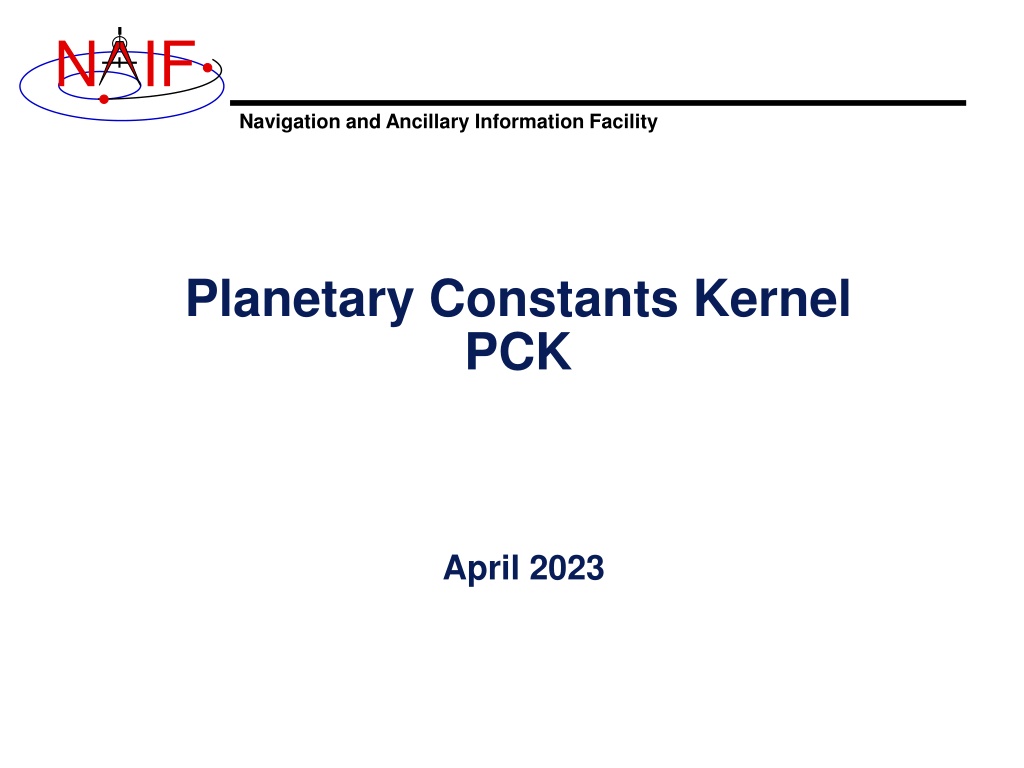
Understanding Planetary Constants Kernel (PCK) Subsystem
The Planetary Constants Kernel (PCK) subsystem includes text and binary kernels for providing orientation and shape models for celestial bodies in the solar system. Text PCKs offer data on size, shape, and orientation, while binary PCKs are used when high accuracy orientation data is available. Learn about the creation, distribution, and usage of PCK files in the context of the Navigation and Ancillary Information Facility (N.IF).
Download Presentation

Please find below an Image/Link to download the presentation.
The content on the website is provided AS IS for your information and personal use only. It may not be sold, licensed, or shared on other websites without obtaining consent from the author. If you encounter any issues during the download, it is possible that the publisher has removed the file from their server.
You are allowed to download the files provided on this website for personal or commercial use, subject to the condition that they are used lawfully. All files are the property of their respective owners.
The content on the website is provided AS IS for your information and personal use only. It may not be sold, licensed, or shared on other websites without obtaining consent from the author.
E N D
Presentation Transcript
N IF Navigation and Ancillary Information Facility Planetary Constants Kernel PCK April 2023
N IF Topics Navigation and Ancillary Information Facility Overview Text PCK Orientation Models Binary PCK Orientation Models PCK reference frames PCK Shape Models Using PCKs Interface Routines PCK Precedence Rules PCK Utility Programs 2 PCK Subsystem
N IF Overview Navigation and Ancillary Information Facility The Planetary Constants Kernel (PCK) subsystem comprises both text and binary kernels. Text PCKs provide orientation and shape models for the sun, planets, natural satellites and a few asteroids and comets. Binary PCKs are used only when very high accuracy orientation data are available. Currently available only for the earth and the moon One still needs to use a text-style PCK to get shape data 3 PCK Subsystem
N IF Text PCKs - 1 Navigation and Ancillary Information Facility Text PCK files contain size, shape and orientation data associated with natural solar system bodies: planets, satellites, and a few comets and asteroids. Some additional kinds of data might also be included. NAIF creates and distributes a generic text PCK based on the latest IAU/IAG Report.* The reports are issued about once every three years, and so might not contain the very latest available results. SPICE PCK software is designed to use these data to compute orientation of body-fixed, body-centered frames. These frames have a name style of IAU_body-name NAIF also provides a masses PCK, containing GM values for the Sun and planetary systems. Values from this file are typically used with SPICE osculating element routines, and in using the MKSPK application to make a Type 5 SPK file. Text PCKs are sometimes produced by flight projects and others not only by NAIF. * Report of the IAU/IAG Working Group on cartographic coordinates and rotational elements: <year issued> ; published in Celestial Mechanics and Dynamical Astronomy 4 PCK Subsystem
N IF Text PCKs - 2 Navigation and Ancillary Information Facility The SPICE text kernel mechanism is used to implement PCK files. Kernel variables contain the mathematical terms appearing in rotation or shape models. For example: BODY699_POLE_RA = ( 40.589 -0.036 0. ) BODY699_POLE_DEC = ( 83.537 -0.004 0. ) BODY699_PM = ( 38.90 810.7939024 0. ) BODY699_RADII = ( 60268 60268 54364 ) Users may easily inspect data in text PCKs. Users may (carefully!) modify text PCKs with a text editor. Data or comments may be added, deleted, or changed. Comments should be added to explain changes. The user may include additional kernel variables to change the base frame or reference epoch. Kernel variable names are case-sensitive. NAIF uses only upper case for variable names; we suggest you do the same. 5 PCK Subsystem
N IF Text PCK Orientation Models - 1 Navigation and Ancillary Information Facility For the sun, planets and a few major asteroids: PCK models use low-degree (typically linear) polynomials to represent RA and DEC of the pole (body-fixed +Z-axis) as a function of time. The prime meridian is also represented by a low-degree polynomial. For a few planets, trigonometric polynomial terms are used to more accurately represent precession and nutation of the pole. R = rotation of the body about its rotational axis P = precession of the bodies rotational axis N = nutation of the bodies rotational axis For natural satellites: In addition to low-degree polynomials for the spin axis and prime meridian, trigonometric polynomial terms are used to more accurately represent precession and nutation. A few satellites have chaotic rotation and so are not modeled. 6 PCK Subsystem
N IF Text PCK Orientation Models - 2 Navigation and Ancillary Information Facility The default base frame for PCK orientation models is the International Celestial Reference Frame (ICRF), as defined by the International Earth Rotation Service (IERS). For historical and backwards compatibility reasons, the reference frame name "J2000" is generally used in SPICE as a label for the ICRF frame, even though J2000 and ICRF are, in fact, not identical. (The difference is under 0.1 arc second.) The default base frame for selected objects may be overridden using text kernel assignments. The default epoch PCK orientation models is J2000 TDB. This epoch also can be overridden for selected objects using text kernel assignments. 7 PCK Subsystem
N IF Text PCK Orientation Models - 3 Navigation and Ancillary Information Facility Body-fixed frames provided in text PCKs have +Z axes consistent with planetocentric coordinate systems. The +X axes of these frames coincide with planetocentric longitude 0. For planets and satellites the +Z axis (+90 LAT) always points to the north side of the invariable plane the plane whose normal vector is the angular momentum vector of the solar system. Planetocentric longitude increases positively eastward Planetocentric latitude increases positively northward Dwarf planets*, asteroids and comets spin in the right hand sense about their positive pole. What the IAU now calls the positive pole is still referred to as the north pole in SPICE documentation. The positive pole may point above or below the invariable plane of the solar system (see above). This revision by the IAU Working Group (2006) inverts what had been the direction of the north pole for Pluto, Charon and Ida. *The dwarf planets are: Ceres, Pluto, Haumea, Makemake, Eris 8 PCK Subsystem
N IF Binary PCK Orientation Models Navigation and Ancillary Information Facility When available, the SPICE system can store high- accuracy orientation model data in binary PCKs. Binary PCKs are limited to storing orientation data. Applications that require shape data must also load a text PCK. Orientation data from a binary PCK always supersede orientation data for the same object obtained from a text PCK, no matter the order in which the kernels are loaded. Binary PCKs for the earth and the moon are available from the NAIF server. The accuracy of these is much better than what is provided in the generic text PCK. See the tutorial "lunar-earth_pck-fk" for details. 9 PCK Subsystem
Location of Text PCK Reference Frame Specifications N IF Navigation and Ancillary Information Facility Many PCK reference frame specifications are built into SPICE. Examples are IAU_SATURN and IAU_TITAN. To use these, load a text PCK file containing orientation data for the body of interest. Typically this is the current generic text PCK Be very cautious about using IAU_EARTH and IAU_MOON; the binary PCKs for these two bodies offer muchmore accuracy. Data for a small number of comets and asteroids are included. Other PCK frames are not built-in and must be defined in a frames kernel that is loaded by your program. Examples are body fixed frames for asteroids or newer natural satellites. See the Frames Required Reading technical reference for information on creating frame kernels that specify PCK reference frames. 10 PCK Subsystem
Location of Binary PCK Reference Frame Specifications N IF Navigation and Ancillary Information Facility Special high-accuracy earth and lunar body-fixed frames are realized using binary PCKs. These frames are named: For the earth: ITRF93 For the moon: MOON_PA and MOON_ME To use high-accuracy earth or moon orientation, load the appropriate binary PCK and allied FK. See the special tutorial lunar-earth_pck-fk for details on these. 11 PCK Subsystem
N IF PCK Shape Models Navigation and Ancillary Information Facility PCK shape models are nominally triaxial ellipsoids For many bodies, the two equatorial axes have the same value; these bodies have a spheroidal shape. For some bodies, one or more radii have not been determined. See the DSK tutorial for information about other kinds of shape models available within SPICE. Although many bodies are in fact modeled as spheres or spheroids, SPICE usually deals with the general, triaxial case. Exception: SPICE supports geodetic coordinate transformations only for bodies modeled as spheres or spheroids. RECGEO, GEOREC, DGEODR, DRDGEO and XFMSTA are the modules performing these transformations. Exception: SPICE supports planetographic coordinate transformations only for bodies modeled as spheres or spheroids. PGRREC, RECPGR, DPGRDR, DRDPGR and XFMSTA are the modules supporting these transformations. 12 PCK Subsystem
N IF Using PCK Data Navigation and Ancillary Information Facility PCK orientation data are usually accessed using frame subsystem or ephemeris subsystem APIs. Example: Get the IAU_SATURN body-fixed reference frame to J2000 position or state transformation matrix at ET: CALL PXFORM ( 'IAU_SATURN', 'J2000', ET, RMAT ) CALL SXFORM ( 'IAU_SATURN', 'J2000', ET, XFORM ) Example: Get the state of Saturn relative to Cassini in the IAU_SATURN body-fixed reference frame: CALL SPKEZR ( 'SATURN', ET, 'IAU_SATURN', 'LT+S', 'CASSINI', STATE, LT ) PCK shape data are usually accessed using APIs needing size and shape data such as SUBPT, SUBSLR, ILUMIN, etc. 13 PCK Subsystem
N IF Interface Routines - 1 Navigation and Ancillary Information Facility Call FURNSH to load PCKs. CALL UNLOAD or KCLEAR to unload them. Call SXFORM to return a state transformation. Returns 6x6 matrix (attitude and angular velocity) CALL SXFORM ( FROM, TO, ET, XFORM ) Call PXFORM to return a position transformation. Returns 3x3 matrix (attitude only) CALL PXFORM ( FROM, TO, ET, RMAT ) Get state of Saturn relative to Cassini in the IAU_SATURN body-fixed reference frame: CALL SPKEZR ( 'SATURN', ET, 'IAU_SATURN', 'LT+S', 'CASSINI', STATE, LT ) Get state of Cassini relative to the DSN station DSS-13 in the J2000 inertial reference frame: CALL SPKEZR ( 'CASSINI', ET, 'J2000', 'LT+S', 'DSS-13', STATE, LT ) An Earth PCK must be loaded in order for this call to work,even though the requested output reference frame is inertial. That s because, in the course of its work, this call must convert the position of the DSN station relative to the Earth s center from an Earth-fixed, earth-centered frame to the J2000 frame. 14 PCK Subsystem
N IF Interface Routines - 2 Navigation and Ancillary Information Facility Call BODVRD or BODVCD to retrieve constants associated with a body. For example: CALL BODVRD ( 'SATURN', 'RADII', 3, N, RADII ) CALL BODVCD ( 699, 'RADII', 3, N, RADII ) These calls retrieve values associated with the variable BODY699_RADII. The variable name is case-sensitive, so the string, RADII, above must be in upper case. You can use general kernel pool fetch routines to fetch data assigned to any non-standard names. GCPOOL, for character data GDPOOL, for double precision data GIPOOL, for integer data 15 PCK Subsystem
N IF PCK Precedence Rules Navigation and Ancillary Information Facility In text PCKs, assignments are of two types: Direct : variable name = value(s) Incremental : variable name += value(s) The last direct assignment made to a given variable replaces any/all previous assignments for that variable. Incremental assignments simply add additional values to an existing variable. The variable will be newly created if it didn t already exist. The sets of rotation model keywords that apply to the same body may be different in different PCKs and may interfere with each other NAIF recommends unloading any text PCK that is meant to be overridden by another text PCK loaded later to prevent data from the first PCK remaining in the POOL and being used erroneously. Orientation data from a binary PCK always supersede orientation data (for the same object) obtained from a text PCK, no matter the order in which the kernels have been loaded. 16 PCK Subsystem
N IF PCK Utility Programs Navigation and Ancillary Information Facility These utilities are included in the Toolkit. BRIEF summarizes coverage for one or more binary PCK files SPACIT generates segment-by-segment summary of a binary PCK file COMMNT reads, appends, or deletes comments in a binary PCK file FRMDIFF samples a PCK-based frame or compares orientation of two PCK- based frames (binary or text PCKs) These additional utilities are provided on the NAIF Web site (http://naif.jpl.nasa.gov/naif/utilities.html). BFF displays binary file format of a binary PCK file BINGO converts binary PCK files between big-endian and little-endian formats 17 PCK Subsystem
N IF Additional Information on PCK Navigation and Ancillary Information Facility For more information about PCKs, look at the following: Most Used Routines document PCK Required Reading document Headers of the routines mentioned Lunar/Earth High-Precision PCK/FK tutorial BRIEF and FRMDIFF User s Guides Related documents: Frames Required Reading Kernel Required Reading NAIF_IDS Required Reading Time Required Reading 18 PCK Subsystem


